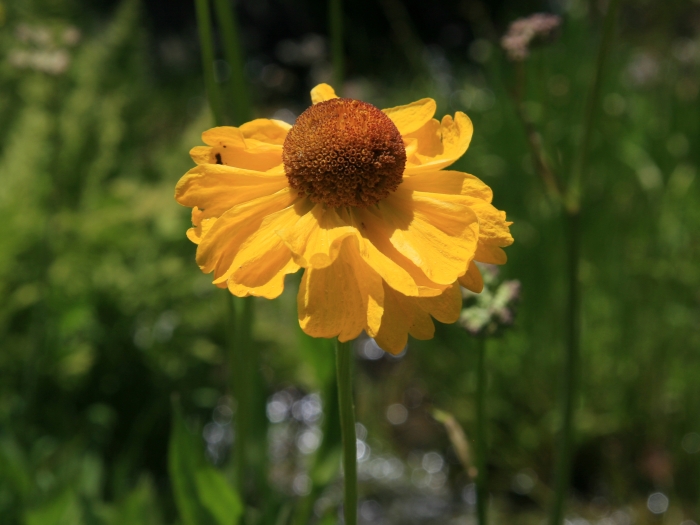Bigelow’s Sneezeweed
(Helenium bigelovii)
Bigelow’s Sneezeweed (Helenium bigelovii)
/
/

Dcrjsr
CC BY 3.0
Image By:
Dcrjsr
Recorded By:
Copyright:
CC BY 3.0
Copyright Notice:
Photo by: Dcrjsr | License Type: CC BY 3.0 | License URL: https://creativecommons.org/licenses/by/3.0 | Uploader: Dcrjsr | Publisher: Wikimedia Commons | Title: Helenium_bigelovii_Bigelow_sneezeweed.jpg | Notes: {{Information |Description={{en|1=Photo showing the habit of ''Helianthus divaricatus''.}} |Source=Own work by uploader |Author=[[User:Jomegat|Jomegat]] |Date=2 Aug 2008 |Permission= |other_versions= }} [[Category:Helianthus d |













































Estimated Native Range
Summary
Helenium bigelovii, commonly known as Bigelow’s Sneezeweed, is a deciduous perennial herb native to the moist meadows, streambanks, and open forests of California and Southern Oregon. It typically grows to a height of 130 cm (51 in; 4.5 ft). Bigelow’s Sneezeweed is characterized by its upright stems and branching arrays that can produce up to 20 flower heads. Each head features 14-20 yellow ray florets with reflexed petals and toothed tips, encircling a central cluster of up to 800 disc florets that change from yellow to brown as they mature. The blooming period occurs in late summer to early fall, and the flowers are quite showy, attracting pollinators such as butterflies and bees.
This plant is valued for its vibrant yellow flowers and its ability to thrive in wet conditions, making it a suitable choice for rain gardens, bog gardens, and areas near water features. It is also used in borders and wildflower gardens for its height and late-season blooms. Bigelow’s Sneezeweed prefers full sun but can tolerate partial shade. It requires consistently moist soil with good drainage and can be watered regularly to maintain high moisture levels. While generally easy to grow, it can be susceptible to powdery mildew and leaf spot, especially in humid conditions. Deadheading spent flowers may encourage additional blooming and prevent self-seeding, as the plant can become somewhat aggressive in optimal conditions.CC BY-SA 4.0
This plant is valued for its vibrant yellow flowers and its ability to thrive in wet conditions, making it a suitable choice for rain gardens, bog gardens, and areas near water features. It is also used in borders and wildflower gardens for its height and late-season blooms. Bigelow’s Sneezeweed prefers full sun but can tolerate partial shade. It requires consistently moist soil with good drainage and can be watered regularly to maintain high moisture levels. While generally easy to grow, it can be susceptible to powdery mildew and leaf spot, especially in humid conditions. Deadheading spent flowers may encourage additional blooming and prevent self-seeding, as the plant can become somewhat aggressive in optimal conditions.CC BY-SA 4.0
Plant Description
- Plant Type: Herb
- Height: 2-3 feet
- Width: 0.5-1 feet
- Growth Rate: Rapid
- Flower Color: Brown, Yellow
- Flowering Season: Summer, Fall
- Leaf Retention: Deciduous
Growth Requirements
- Sun: Full Sun
- Water: High
- Drainage: Medium
Common Uses
Bank Stabilization, Bee Garden, Bird Garden, Border Plant, Butterfly Garden, Deer Resistant, Drought Tolerant, Hummingbird Garden, Rabbit Resistant, Showy Flowers, Water Garden
Natural Habitat
native to the moist meadows, streambanks, and open forests of California and Southern Oregon
Other Names
Common Names:
Scientific Names: Helenium bigelovii , Helenium rivulare , Heleniastrum bigelowii , Heleniastrum rivulare , Helenium bigelovii var. bigelovii , Helenium puberulum var. bigelovii
GBIF Accepted Name: Helenium bigelovii A.Gray